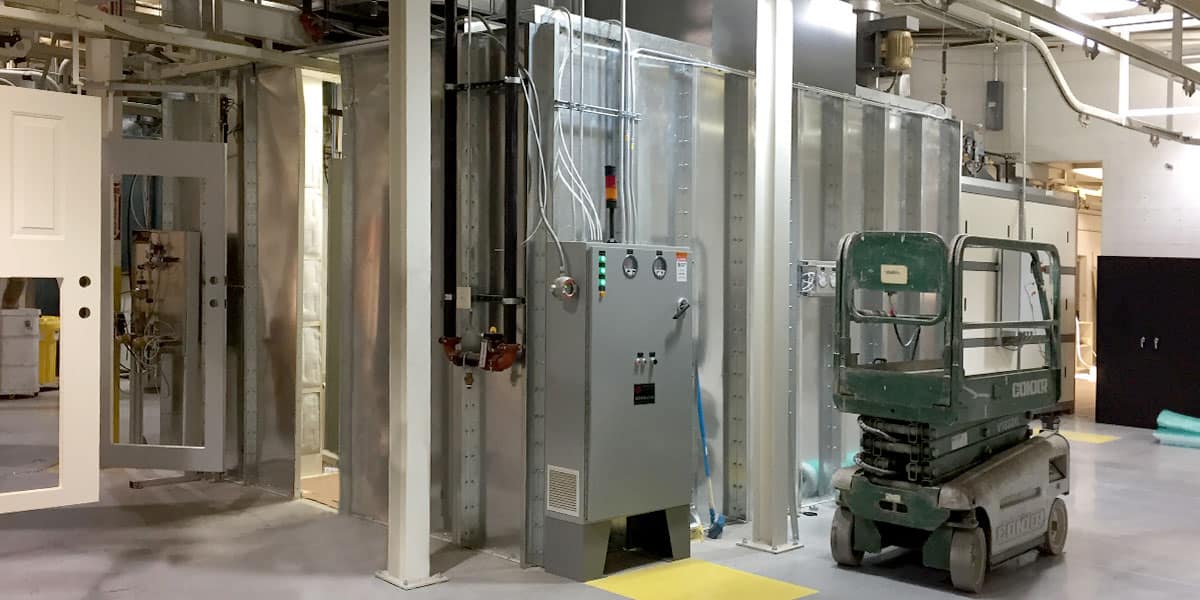
To recirculate air or not to recirculate? That is the question facing industrial manufacturers needing a new paint booth that offers temperature and humidity controls for specific liquid coatings.
Recirculating spray booths provide energy savings by reducing the volume of make-up and exhaust air for the booth while maintaining accurate control of climate and airflow. They also offer capital expense savings, as air handling and abatement equipment are reduced in size when using a recirculation booth.
While climate-controlled recirculating spray booths can be as much as three times the cost of non-climate-controlled, standard paint booths, they can be cheaper in the long run because of the energy savings from air recirculation.
Typically used for custom industrial and aerospace applications, where climate control is essential for the painting process, recirculating paint booths heat, cool, de-humidify or humidify only the incoming fresh air. In many applications, the incoming fresh air accounts for just 20 to 30 percent of the total air that moves through a recirculating spray booth.
In Global Finishing Solutions (GFS) Recirculating Spray Booths, the Consta-Flow System — consisting of a variable frequency drive (VFD), differential pressure gauge and sensing probes — maintains constant airflow in the booth, automatically adjusting the recirculation fan to the changing conditions of the exhaust filters. Meanwhile, the Auto-Balance System maintains a constant pressure in the booth’s cabin, regardless of filter loading. The result is a spray booth with consistent airflow through the spray area and a perfect booth balance.
When spraying in a recirculating paint booth, even when using robots or fixed or electrostatic spray guns, air must still be exhausted to the outside. While recirculating spray booths remove 99.9 percent of particulates down to 0.5 microns, volatile organic compounds (VOCs) still exist and must be removed before they are concentrated above safe levels.
According to NFPA 33, a paint booth “must provide adequate ventilation to control the concentration of flammable vapors below 25 percent of the lower explosive limit (LEL).” GFS designs recirculating paint booths to meet fire safety standards, including alarms and shutdowns to prevent the spray booth from exceeding the LEL.
Industrial hygienists determine the appropriate level of personal protective equipment (PPE) required for painters, based on the chemical concentrations in the paint booth. PPE may consist of a full-body suit, with the painter plugged into an uncontaminated air source, so that the painter is not breathing the VOCs inside the spray booth. Some industrial manufacturers take their painters out of the equation by utilizing robotics.
Despite the additional safety precautions necessary when operating a recirculating spray booth, it is an attractive option for surface finishers because of the numerous advantages, including tighter temperature and humidity control; energy cost savings; and improved quality of coatings.
One of the best ways to highlight your business is through a story that you can share across your online platforms. It humanizes your business and shows that your business can make a meaningful impact. Your testimonial would be used as a project profile on the GFS Booth Blog and can be shared on your website and/or social media channels.
Complete this form and we’ll be in touch to showcase your company.

Shop a variety of GFS aftermarket products, including booth protection products and mobile accelerated curing units. And enjoy the convenience of fast and free ground shipping throughout the contiguous United States.

Located at GFS’ headquarters in Osseo, Wisconsin, the Center for Excellence is an innovative facility featuring an automotive refinish training center, as well as a separate space dedicated to technical product training.

GFS is continuously searching for talented, ambitious individuals to join our team. We aim to provide our employees with every opportunity to make an impact on the company and find their niche along the way — weather in a production, field services or an office position.